STARVE ACRE: A Grim Folk Horror

Starve Acre is a folk horror piece in service of analyzing the psychology of grief.
England, 1970s. Archeology lecturer Richard, his wife Juliette, and their asthmatic son Owen move from a big city to Starve Acre, Richard’s ancestral estate in rural Yorkshire. Shortly after the move, Owen begins exhibiting disturbing behavior: he tortures animals and tells his parents he hears whispers and whistles from “Jack,” a mythical figure linked to the Devil, introduced to him by their neighbor Gordon. Owen soon dies from an asthma attack, plunging Juliette into deep depression while Richard immerses himself in work. One day, Richard uncovers a hare’s skeleton on the property, reassembles it, and places it in a box. Mysteriously, the remains grow flesh and fur and come back to life. It is revealed that Starve Acre was once the site of strange rituals performed by Richard’s father.

Starve Acre is an adaptation of a novel by Andrew Michael Hurley, a British writer known for The Loney (winner of the 2015 Costa Award for Best Debut) and the short story The Green Cascade from the collection Ghost Season: Eight Chilling Tales for Long Winter Nights. The film was adapted by director and screenwriter Daniel Kokotajlo, whose feature debut Apostasy (2017) earned a BAFTA nomination. Speaking about Starve Acre, Kokotajlo noted: “I was impressed by the level of detail and the storytelling approach. After reading the book, thoughts about spring, rebirth, and resurrection stayed with me. The novel spoke to me on a religious and spiritual level.” The film adaptation, starring Matt Smith as Richard and Morfydd Clark as Juliette, premiered at the BFI London Film Festival in October 2023 before entering wider theatrical release the following year.
Like Hurley’s novel, Kokotajlo’s film blends bleak folk horror with psychological drama. The former contributes elements of ominous, untamed nature and ancient pagan rituals, while the latter explores the despair of grieving young parents grappling with loss and mourning. The supernatural (the demonic hare, local legends, a revered old tree) and the realistic (the gradual emotional drift between Richard and Juliette after Owen’s death) form the two intersecting threads of Starve Acre. Kokotajlo drew inspiration from 1970s British television horror, such as Lawrence Gordon Clark’s A Warning to the Curious (1972) and John Cooper’s Murrain (1975), along with films like Don’t Look Now (1973) by Nicolas Roeg, Penda’s Fen (1974) by Alan Clarke, and Valdimar Jóhannsson’s Lamb (2021).

The film’s greatest strengths are its dense, foreboding atmosphere, deliberate pacing, and evocative cinematography. The stark Yorkshire landscape, captured by cinematographer Adam Scarth, both awes and unsettles, echoing Hurley’s intention to “dispel the idea that England is a green and pleasant land where one can find peace and refuge.” As is typical of folk horror, the rural setting in Starve Acre is far from idyllic, and nature offers neither solace nor shelter; instead, it is an unstoppable, ruthless force reclaiming what humanity has taken (as Kokotajlo noted, the story can be seen as a tale of nature’s revenge). While the film succeeds in portraying the boundless sorrow of grief, it struggles with what is arguably the essence of horror: creating tension and fear. Nevertheless, Starve Acre is worth watching, as there can never be too many British folk horrors.

